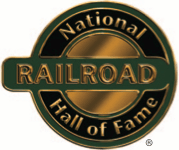National Railroad Hall of Fame facts for kids
The National Railroad Hall of Fame is a special place that honors people and groups who have made a big difference in the history of railroads in the United States. It was started in 2003. The main offices for the Hall of Fame are in Galesburg, Illinois. This organization celebrates the amazing achievements that helped shape how trains and railways developed across the country.
The National Railroad Hall of Fame places its honored members into three main time periods. These periods help show how railroads grew and changed over the years.
Contents
Honoring Railroad Heroes: The Inductee Eras
The Hall of Fame recognizes people from different times in railroad history. These periods help us understand the journey of trains and railways.
Birth and Development: 1800-1865
This first era covers the very beginning of railroads in the United States. It includes the time when the first steam locomotives were invented and when the first railway lines were built. People honored in this period helped create the basic ideas and technologies for trains. They laid the groundwork for future railway expansion.
Some of the important people from this time include:
- Horatio Allen: An engineer who helped build early railroads.
- Matthias W. Baldwin: A pioneer in building steam locomotives.
- Peter Cooper: An inventor who built one of America's first steam locomotives.
- Abraham Lincoln: A U.S. President who supported railroad expansion.
- George Pullman: Known for designing comfortable railway sleeping cars.
- Col. John Stevens: An early advocate for steam power and railroads.
Golden Era: 1866-1945
The "Golden Era" was a time of huge growth for railroads. During these years, railway networks spread across the entire country. Trains became a main way to travel and transport goods. This period saw many new inventions and improvements in train technology and railway operations. People honored from this era helped connect the nation and make train travel more efficient.
Some notable figures from this period are:
- Andrew Jackson Beard: An inventor who improved train couplers for safety.
- Grenville M. Dodge: A key engineer in building the Transcontinental Railroad.
- Henry M. Flagler: Developed railroads in Florida.
- James J. Hill: Known as the "Empire Builder" for his railroads in the Northwest.
- Elijah McCoy: An inventor who created important lubrication devices for trains.
- J.P. Morgan: A financier who played a role in railroad consolidation.
- Cornelius Vanderbilt: A famous businessman who built a railroad empire.
- George Westinghouse: Invented the air brake, making trains much safer.
Modern Era: 1946-Present
The Modern Era focuses on railroads from after World War II up to today. This period includes the shift from steam to diesel locomotives. It also covers the development of faster trains and new ways to manage railway systems. People honored in this era helped railroads adapt to new challenges and continue to be an important part of transportation.
Some of the people recognized in this modern time include:
- John W. Barriger, III: A leader who helped modernize railroads.
- Max and Thelma Biegert: Known for their work with scenic railroads.
- W. Graham Claytor, Jr.: A former president of Amtrak.
- Joshua Lionel Cowen: The founder of Lionel Corporation, famous for toy trains.
- Asa Philip Randolph: A civil rights leader who organized railroad workers.
More Information
If you want to learn more about the National Railroad Hall of Fame and the people they honor, you can visit their official website.
- Official website: http://www.nrrhof.org/
- List of inductees


